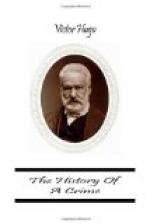CHAPTER IX.
THE PORTE SAINT MARTIN
Important deeds had been already achieved during the morning.
“It is taking root,” Bastide had said.
The difficulty is not to spread the flames but to light the fire.
It was evident that Paris began to grow ill-tempered. Paris does not get angry at will. She must be in the humor for it. A volcano possesses nerves. The anger was coming slowly, but it was coming. On the horizon might be seen the first glimmering of the eruption.
For the Elysee, as for us, the critical moment was drawing nigh. From the preceding evening they were nursing their resources. The coup d’etat and the Republic were at length about to close with each other. The Committee had in vain attempted to drag the wheel; some irresistible impulse carried away the last defenders of liberty and hurried them on to action. The decisive battle was about to be fought.
In Paris, when certain hours have sounded, when there appears an immediate necessity for a progressive movement to be carried out, or a right to be vindicated, the insurrections rapidly spread throughout the whole city. But they always begin at some particular point. Paris, in its vast historical task, comprises two revolutionary classes, the “middle-class” and the “people.” And to these two combatants correspond two places of combat; the Porte Saint Martin when the middle-class are revolting, the Bastille when the people are revolting. The eye of the politician should always be fixed on these two points. There, famous in contemporary history, are two spots where a small portion of the hot cinders of Revolution seem ever to smoulder.
When a wind blows from above, these burning cinders are dispersed, and fill the city with sparks.
This time, as we have already explained, the formidable Faubourg Antoine slumbered, and, as has been seen, nothing had been able to awaken it. An entire park of artillery was encamped with lighted matches around the July Column, that enormous deaf-and-dumb memento of the Bastille. This lofty revolutionary pillar, this silent witness of the great deeds of the past, seemed to have forgotten all. Sad to say, the paving stones which had seen the 14th of July did not rise under the cannon-wheels of the 2d of December. It was therefore not the Bastille which began, it was the Porte Saint Martin.
From eight o’clock in the morning the Rue Saint Denis and the Rue Saint Martin were in an uproar throughout their length; throngs of indignant passers-by went up and down those thoroughfares. They tore down the placards of the coup d’etat; they posted up our Proclamations; groups at the corners of all the adjacent streets commented upon the decree of outlawry drawn up by the members of the Left remaining at liberty; they snatched the copies from each other. Men mounted on the kerbstones read aloud the names of the 120 signatories, and, still more than on the day before, each significant or celebrated name was hailed with applause. The crowd increased every moment—and the anger. The entire Rue Saint Denis presented the strange aspect of a street with all the doors and windows closed, and all the inhabitants in the open air. Look at the houses, there is death; look at the street, it is the tempest.




